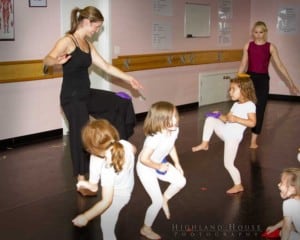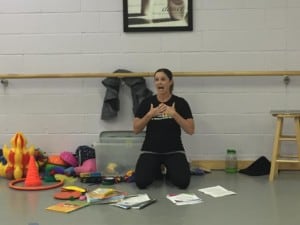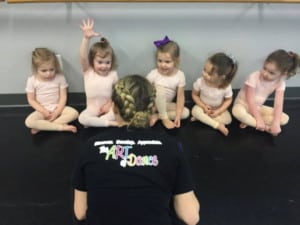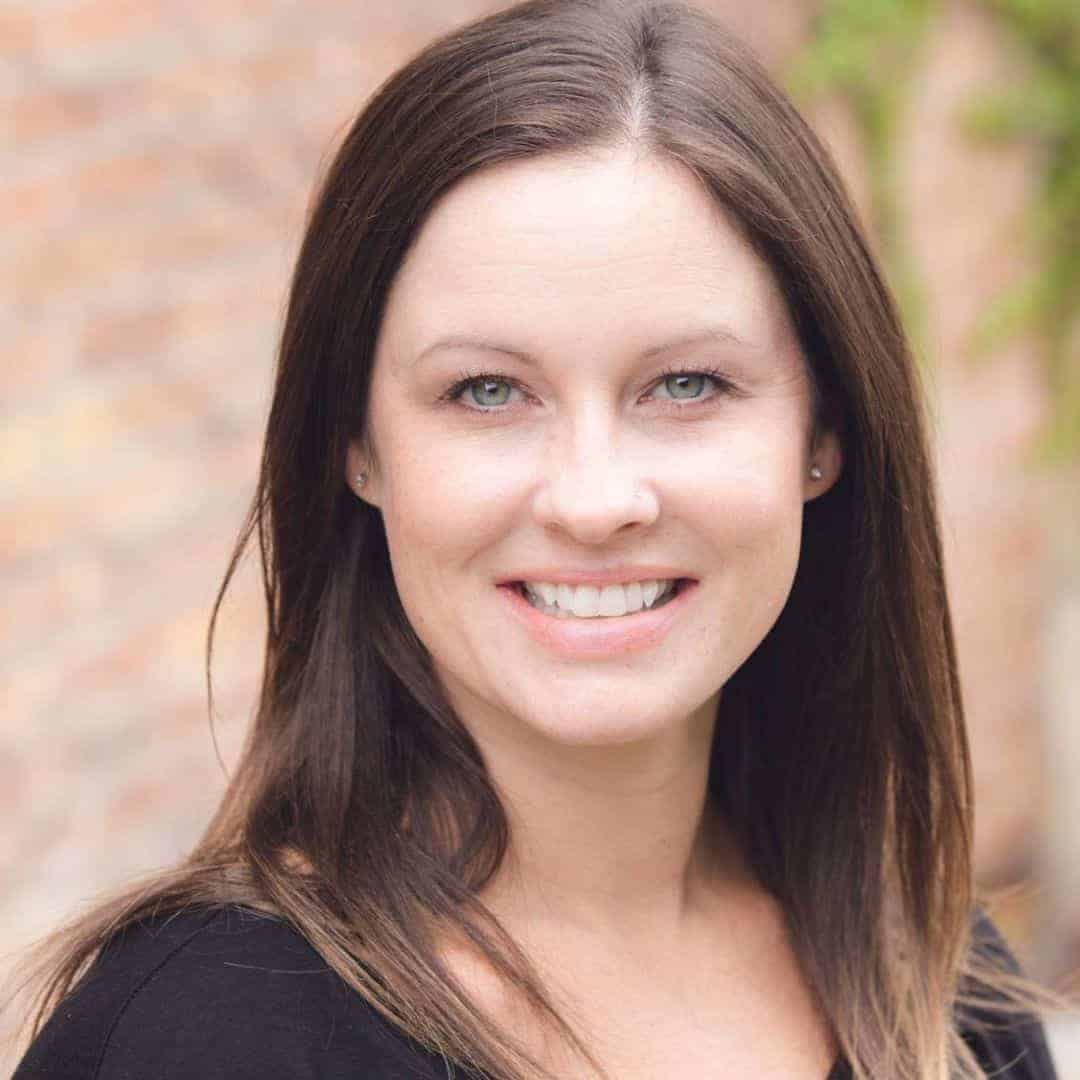5 Tips for Teaching Preschoolers Choreography
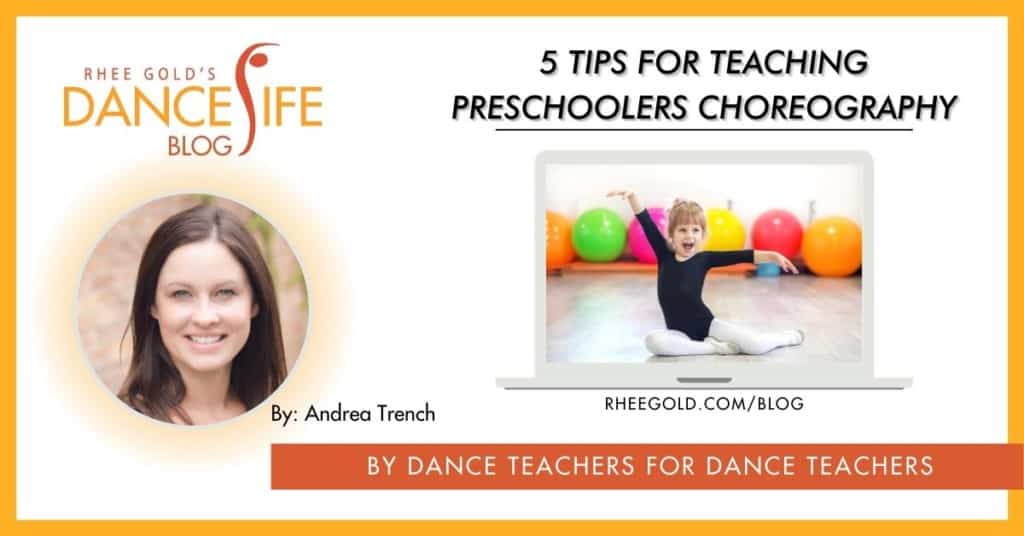
Challenges with learning choreography for performance include short attention spans, lack of interest, complicated movement and formations, and difficulties remembering material.
Today, I’m sharing five tips to not only improve the choreographic experience with your little ones, but to also bring light to realistic expectations across three different developmental stages. I will list these stages as Stage 1, Stage 2, and Stage 3. After evaluating your students, you can choose which stage is best for each class as a whole.
Tip #1. Choose Your Music Wisely
A complicated piece of music can set your students up for failure before the choreography even begins. Choosing music that has a simple time signature will help dancers connect with the music and therefore help memory retention as the learning progresses. In addition, consider the following across the developmental stages.
Stage 1: Choose music that tells the dance. These are action or directive songs. Example: Music See, Monkey Do, Kindermusik International
Stage 2: Choose music that tells the story. The dancers match their movement to the story. Example: Never Smile at a Crocodile, Kathy Williams
Stage 3: Choose music that allows the dancers to tell the story. In this stage, the presence of both lyrics and instrumental music encourages the dancers to continue the story throughout the song. Example: Come Fly with Me, Kindermusik International
Tip #2. Use Familiar Formations
Think about how you can incorporate dance formations into your weekly classes. Consider assigning spots for your dancers during class. These class spots become their performance spots. Since they have been moving on their spot, around their spot, and back to their spot all season long, they will have no problem finding their spot when it’s time for choreography. Perhaps you begin in two lines and move into a circle during your warm-up. This formation change can then easily be incorporated into your choreography, because you have been practicing it all season long. In addition, consider the following across the developmental stages.
Stage 1: Choreography stays on their spot. These are your youngest dancers. Keep them where they are. I promise, they will still steal the show!
Stage 2: Choreography stays on and around assigned spots. Dancers may move around their spot, hug a friend and move back to their spot, or side slide off their spot and back to it.
Stage 3: Choreography travels through class formations. For example
- two lines, circle, two lines
- start off stage in two lines, run to spots, circle, two lines
- one line, circle, one line
- two lines, circle, two lines, change lines
Whatever you do for warm-up, that’s what you include in your choreography.
Tip #3. Teach When They’re Fresh
For me, growing up in dance we would warm-up, do our center work, progressions across the floor and then after all that really hard (mostly teacher-directed) work we would be expected to do more teacher-directed work by learning our recital dance. When I started teaching, that was my class framework as well. However, when I started really listening to my students and observing their behavior as the end of class rolled around, I noticed their lack of enthusiasm, energy, and off-task behavior. So, I changed where I taught choreography and you can too! Catch their brains and bodies while they are fresh and teach choreography right after warming up across all developmental stages.
Tip #4. Teach With Realistic Expectations
Follow-Me Strategy: Instead of teaching the choreography- just show it. Little ones will learn from mirroring your movement. If you spend too much time explaining every step-by-step detail, you will lose them and begin to see off-task behavior. By using the follow-me strategy, you are demonstrating for your visual learners, you are singing the words to the music or steps for your auditory learners, and you are actually having the dancers perform with you for the kinesthetic learners. This keeps your dancers engaged during the learning process because you are teaching through multiple learning styles.
Ditch the Counts: Counting music at this age is an added layer that is not necessary. Think about how complex musicality is… we have to first be able to find the beat in the music. Then we have to coordinate our movement (either clapping, stomping, or hitting rhythm sticks, for example) on the beat. Then, we have to know how to count the beats to 8. THEN, we have to be able to coordinate our movement to the counts of 8. THEN we have to be able to coordinate our movement to the counts and connect them with the counts of the music. Not to mention, we have to understand the concept of speed (aka tempo), energy, and weight to be able to control our movement with the appropriate counts. And on top of all of that, we have to be able to control our body. In order to have body control, we first have to be aware of our body in space, and before we can develop body awareness we have to be able to identify our body parts. That’s a lot for a 3 year old!
Setting realistic expectations at this age means we are working on all. the. things. that lead to musicality, but we know that realistically we are not ready to coordinate all. the. things. simultaneously. This means moving to the music or lyrics is more of our reality with preschoolers and being able to dance with counts is the foundation we are setting. As they progress through their dance training the connections will begin to hardwire. Can we count out loud as we heel dig for three counts and stamp on count 4? Of course. But, hammering in the counts and movement for an entire dance on a brain and body that is not yet to that level of comprehension is unnecessary and not developmentally appropriate.
Limit Choreography Time: Lastly, limit the time spent working on choreography during each class. Preschoolers can focus on a teacher-directed activity for 5-6 minutes. Learning choreography is a teacher-directed activity. Consider the following across the developmental stages.
Stage 1: Perform dance once during class.
Stage 2 and 3: Beginning after the first week of choreography…
- Dancers perform choreography without the teacher’s assistance. This is an important step in their memory development. Each week, play the music, sit back, and watch their little brains work. At first, not much will be happening. But, as they continue to build their sequencing and memory skills, you will see them remember more and more of their dance. And when you see it, you encourage them. “That’s it.” “You remember!” “Yep!” “Uh Huh!” “You got it!” Now, they may not be doing it in order or at the right part of the music, but they are remembering something.
- Next, repeat choreography with the teacher and the teacher adds on new choreography while the students follow. Only stop to explain formation changes or unfamiliar movement. I encourage you not to use unfamiliar movement, but if you must, be sure to stop and show it.
- The third and final time, repeat choreography with the teacher and the new material. Done!
This formula becomes part of our routine. Processing the choreography through our learning style when our bodies and brains are still fresh and excited to be in dance class helps us stay focused. In turn, we are creating an environment where learning can effectively take place so we don’t have to spend a ton of class time working on our dances to reach our goals.
Tip #5 Choreograph With Realistic Expectations
Setting our dancers up for success should be our top priority. We want to challenge our dancers, yes, but we must consider their development. We must also provide the proper tools needed to achieve the goals we set for them. Your choreography should reflect your class objectives and highlight your students’ progress. With developmentally appropriate objectives, choreography will be easy. If it’s not easy, consider that oftentimes we place unrealistic expectations on our students. It is up to us, their teachers, to identify the challenges and provide the support they need.
Before you begin choreographing on this age group, reflect and evaluate the experience you will provide so you and your students can thrive in an effective and developmentally appropriate learning environment. If you would like more resources to help create such a learning environment, comment below or connect with me and let’s keep this conversation going.
Andrea Trench is dedicated to helping dance teachers create and deliver content that is research-based and developmentally appropriate for children under the age of 6. Her primary focus is classroom management, conceptual teaching, and foundational movement skill development in early childhood dance education. In addition, Andrea uses her 12 years of experience as a partner in a dance studio to inspire, equip, and empower educators.






